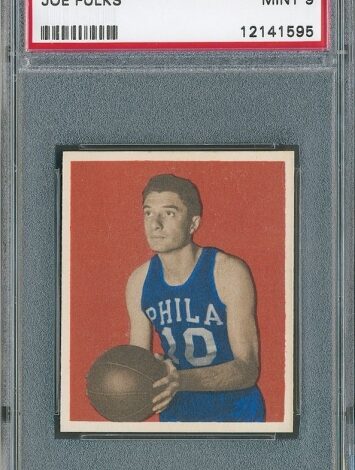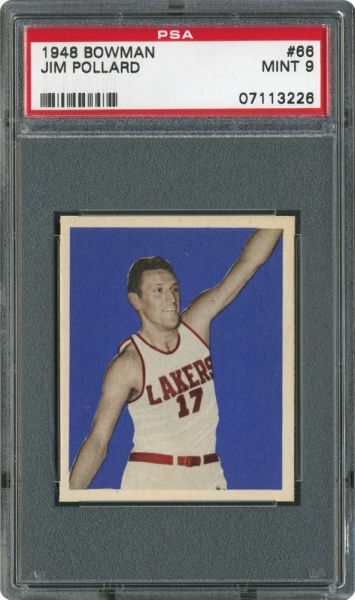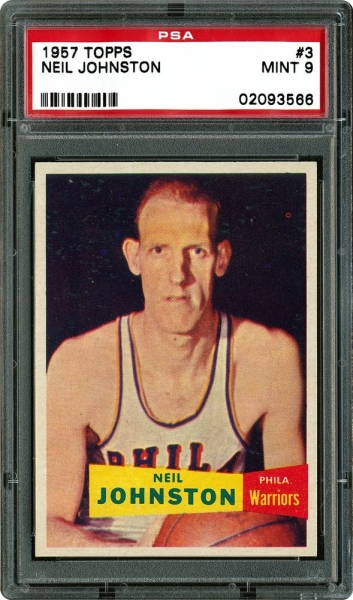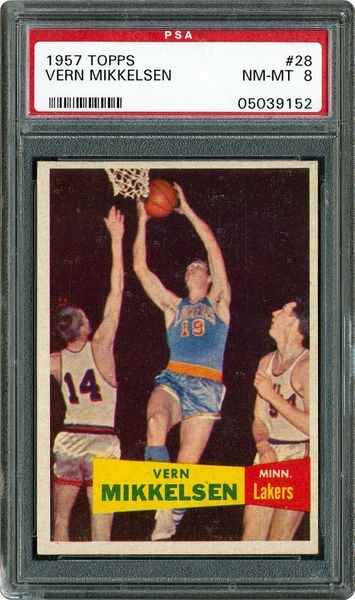Overlooked and Underrated Rookie Cards of NBA Greats – Part 1, the Early Days

In terms of recognition and fame, the early days of pro basketball were a fraught time to be a “merely great” player. Center stage belonged to the big men of the days: Russell, Chamberlain and, later, Kareem immediately come to mind. Of course, before any of those guys ever took the floor, there was Mikan. Unlike any player in history, Mikan was the league. He was arguably bigger than the league. What limelight remained was largely divvied up among Bob Pettit, Bob Cousy, Dolph Schayes and Paul Arizin.
This imbalance in recognition, combined with the oft-discussed hiatuses in mainstream basketball cards during the middle of the last century, has created an extremely impressive lineup of rookie cards, of genuine greats and Hall of Famers, whose bargain bin prices do no justice to the impact and achievements they represent – headlined by this quartet:
Joe Fulks (1948 Bowman, #34)
Total PSA pop (including half grades, but not qualifiers, “No Red Ink on Front” or “No Red/Overprint Back”): 293 (2 PSA 9s, 36 8s, 2 7.5, 36 7s, one 6.5, 60 6s, 7 5.5, 52 5s, 6 4.5, 47 4s)
After two years at Murray State and four with the Marines, at age 25, Joe Fulks joined the BAA (Basketball Association of America, which became the NBA in 1949) ahead of the league’s inaugural 1946-47 campaign.
Even by the standards of the game’s early, inefficient days, Fulks was a volume scorer. Through his first three seasons, he averaged a whopping 27.6 field goal attempts per game, of which he made 29.5%. Nonetheless, the guy got results.
Fulks chucked his way to scoring titles in each of his first two seasons, with averages of 23.2 and 22.1 points per game. He posted a career-best 26 per game in his third season, 1948-49, but was bested by a rookie named George Mikan.
As a rookie, in addition to leading the league in scoring, he posted the league’s second-best Win Share total (16.3), and led the Philadelphia Warriors to pro basketball’s first-ever championship. He led the Warriors back to the Finals the following year, where they ultimately fell to the Baltimore Bullets.
Pro basketball’s first bona fide bucket-getter, Fulks was the first player ever to score 35+ points in a game, doing so three times before anyone else, and accounting for six of the league’s first eight 35-point performances. He was also the first player ever to break the 50-point barrier, blowing past the mark with 63 in a February 1949 game against the Indianapolis Jets. His record stood for over a decade, until Elgin Baylor put 64 on the Celtics in November 1959.
In all, Fulks played eight BAA/NBA seasons, during which he averaged 16.4 points (the sixth-best mark over that span), and earned 4 all-league selections (three of them first team), two All-Star nods (the All-Star Game didn’t exist until his fifth season) and, ultimately, a spot in the Hall of Fame.
There are only three cards of Fulks from his playing days. Only one, his 1948 Bowman rookie, was a mainstream release. The card, like all the others in the set, is overshadowed in the set by the Mikan rookie. However, the set’s fourth-most- graded card is aesthetically appealing in a way that most others from the set simply are not. The red background contrasts beautifully with an always-ready-to-shoot Fulks’ clearly visible blue “Phila” jersey.
Where it also stands out is as a value, with eBay sales of graded versions since June 2021 coming in between about $120 (PSA 4) and $685 (two PSA 8s in this range), with a PSA 6 ($225) and a PSA 8 (OC) ($212) selling for very palatable sums in between.

Jim Pollard (1948 Bowman, #66)
Total PSA pop: 172 (6 PSA 9s, 19 8s, 4 7.5, 27 7s, 1 6.5, 30 6s, 2 5.5, 29 5s, 4 4.5, 22 4s)
A Day One Laker, Pollard was not only the first superstars in franchise history, but, along with Mikan, the only member of all five Minneapolis title teams.
Pollard spent his entire seven-year career with the Lakers, averaging 13.2 points, 7.8 rebounds (which weren’t tracked until his third season) and over three assists per game. He earned two All-NBA First Team selections, four All-Star selections (there was no All-Star Game until his third season) and, in 1978, enshrinement in the Hall of Fame.
In 72 career postseason games, he bettered his regular season numbers, averaging 13.6 points, 8.1 rebounds (in 50 games with rebounding stats) and 3.6 assists per game.
Beyond all of that, Pollard was one of pro basketball’s first get-you-out-of-your-seat stars. Legend has it that “the Kangaroo Kid” would fire up crowds pre-game with dunks from the free throw line during warmups.
Like Fulks, but one mainstream card of Pollard was released during his playing days, also as part of the 1948 Bowman set. Like the Fulks card, Pollard’s features a clear image of the Lakers’ star, with number and team name clearly visible.
Even taking into account a slight Lakers premium, Pollard’s RC does not break the bank. In the months prior to writing, a pair of PSA 7s sold for $721 and $732 (as did a PSA 2, for $177.50). During this same period, a pair of raw versions, each seemingly in good condition, sold for about $400.
Not too bad for a high-grade, near-75-year-old rookie card of a superstar from the sport’s first dynasty.

Neil Johnston (1957 Topps, #3)
Total PSA pop: 286 (1 PSA 9, 1 8.5, 16 PSA 8, 43 7s, 97 6s, 3 5.5, 69 5s, 1 4.5, 40 4s)
Eighteen players in BAA/NBA history have played at least 400 games while posting a Player Efficiency Rating (PER) of at least 24 and at least .20 Win Shares per 48 minutes (WS/48). The suspects are usual: Jordan, Magic, Kareem, Shaq, Wilt, Mikan, Duncan, Robinson, Barkley, Pettit, plus a still-active contingent of LeBron James, Steph Curry, Kevin Durant, Chris Paul, Anthony Davis, Nikola Jokic, and James Harden.
It’s not every legend the sport’s ever produced, but it’s certainly a representative sample.
Of course, there’s one more member in this club, whose name carries none of the recognition of the other seventeen.
In 516 career regular season games – 77 more than Mikan – Neil Johnston averaged over 19 points and 11 rebounds, with a 24.7 PER and .241 WS/48. His career PER is better than those of Kareem, Barkley, Duncan, Magic and Chris Paul. His WS/48 mark, meanwhile, is tied with Paul’s, and trails only those of Jordan, Robinson, Mikan and Wilt.
Johnston spent all eight of his pro seasons with the Philadelphia Warriors, picking up where Fulks left off. During his six-year peak (1953-58), he earned six earned All-Star selections, four All-NBA First Team (and one Second Team) selections, and won three consecutive scoring titles. He made nearly 45% of his shots at a time when virtually no one made 45% of their shots, and thus led the league in shooting three times, with three other top-seven finishes. In 1955-56, Johnston and fellow star, scoring machine “Pitchin’ Paul” Arizin led the Warriors to the franchise’s first-ever championship.
Had the league established its MVP award by 1954-55 (it was introduced in 1955-56), Johnston would have been the obvious choice, capturing a third straight scoring title, while leading the league in rebounding (15.1 per game), and Offensive and Total Win Shares.
During his peak (omitting his first and last seasons, during which he averaged roughly 6 point and 5 rebounds), Johnston averaged 22.3 and 12.7 rebounds – less a point and a rebound shy of Mikan’s career marks – and posted .249 WS/48 – .001 below Jordan and Robinson’s all-time mark.
Certain stylistic and social factors (pro basketball’s color line was broken in 1947, but the league was hardly welcoming to Black players in the 1950s) certainly contributed to his dominance. However, Johnston’s achievements are those of a legitimate all-time great.
Unfortunately, a number of factors have conspired to keep Neil Johnston from receiving the recognition that he is due:
Missing out on an MVP award didn’t help. Neither did an early retirement (at age 29), brought about by knee issues. Also, in his prime, Johnston was overshadowed by Mikan, and later his achievements were dwarfed by those of Wilt and Bill Russell. Finally, sadly, Johnston wasn’t inducted into either the Basketball Hall of Fame (1990) or the College Basketball Hall of Fame (2006) until well after his untimely passing in 1978, and was excluded from the NBA’s “Top 50 Players” list in 1997.
According to PSA pop reports, only a single Neil Johnston card, mainstream or otherwise, was produced during his playing days. Fittingly, that card – from 1957 Topps – is also dwarfed by Bill Russell’s. Less fair, however, is the fact that it’s not garnered even a modest amount of historical significance.
Admittedly, it’s not much to look at. However, given its rarity and Johnston’s awesome body of work, it’s an absolute steal for fans of pro basketball’s early days, with raw versions (of varying quality) available for under $100, and graded EX/NM versions fetching under $150.

Vern Mikkelsen (1957 Topps, #28)
Total PSA pop: 275 (one PSA 9, 21 PSA 8, 45 PSA 7, 3 6.5, 103 6s, 60 5s, 30 4s)
Along with Pollard and Mikan, Mikkelsen is one of the Lakers’ first superstars, and a vital piece of the Minneapolis dynasty. He joined the Lakers in 1949, a year into their run, and spent all ten of his NBA seasons with the team, winning four titles.
In 699 career games, Mikkelsen averaged 14.4 points and 9.4 rebounds per games and averaged a double-double four times. Along the way, he earned six All-Star selections, four All-NBA Second Team selections, and the dubious title of the “most fouled-out” player in NBA history (127). Mikkelsen was inducted into the Basketball Hall of Fame in 1995, alongside his legendary coach, John Kundla.
Like Pollard’s, Mikkelsen’s raw numbers are not as eye-watering as those of other greats. This, tends to unfairly obscure his greatness. But, consider: Seventeen players have racked up at least 50 Win Shares as Lakers. (Before we move on, take a moment and consider how crazy that is). Not only is Mikkelsen on the list, his tally is good for eighth – and not because he was simply an accumulator, as his overall (18.7 PER) and per-minute efficiency (.17 WS/48) marks also rank in the top ten.
Like Johnston, Mikkelsen made just one mainstream cardboard appearance, in the 1957 Topps set. The two have been submitted to PSA in similar number, with fairly similar results. Unlike the Johnston, though, this card is spectacular looking, with an action shot of Mikkelsen attacking the rim against the Warriors, the baby blue and gold of the Lakers’ Minneapolis jerseys front and center.
Considering his status in the game, Mikkelsen is one of the best bargains among vintage Hall of Famers. PSA 6s of this gem can often be found for $300 or less and, in the months prior to writing, a PSA 7 sold for $500 and a one of the 21 PSA 8s in existence fetched $1,675. Not nothing, but hardly the Lakers premium one might expect.
Those are our picks for underrated former greats of the NBA’s genesis, but there are certainly others from the two sets worth considering.
Next up… the 1960s!




